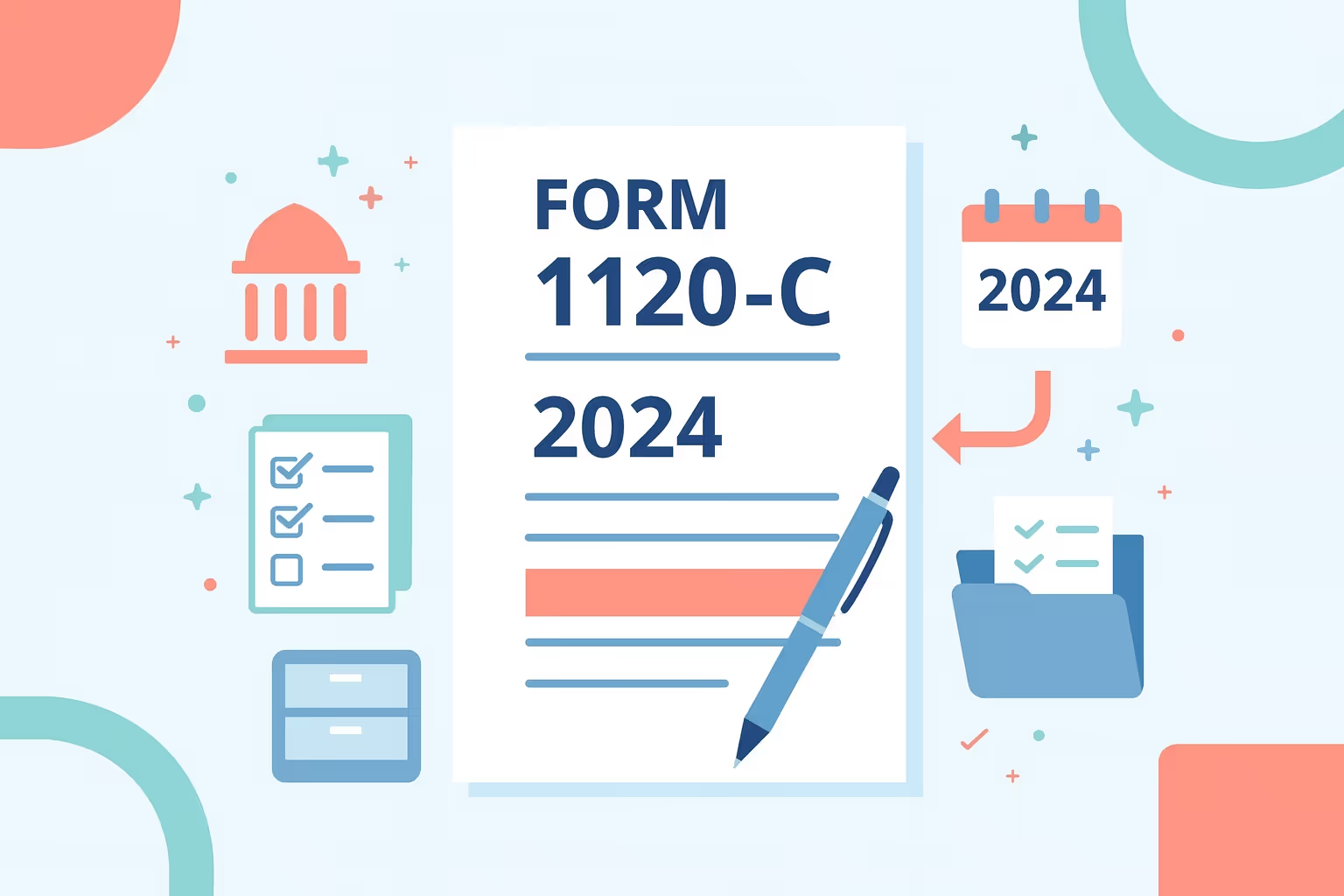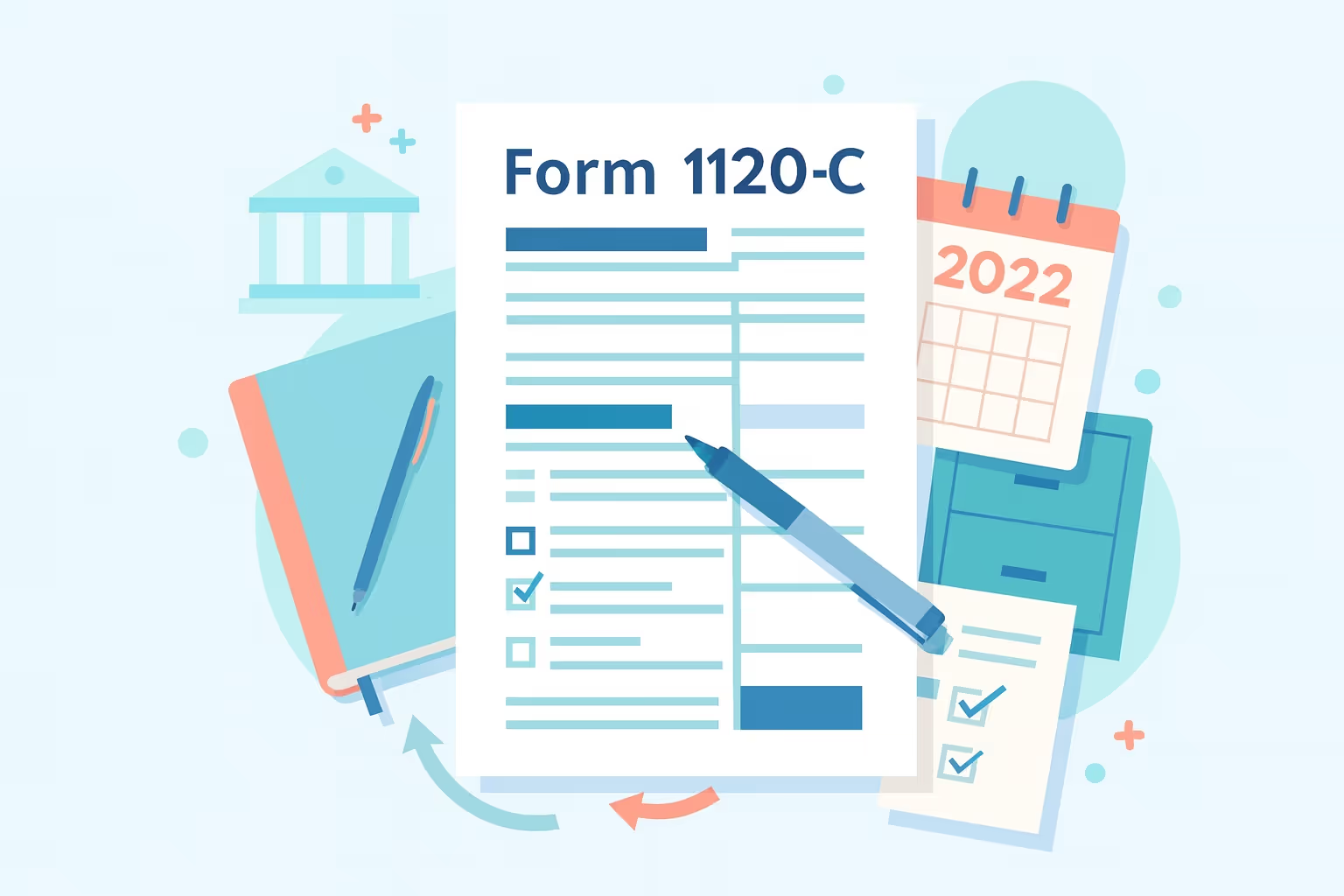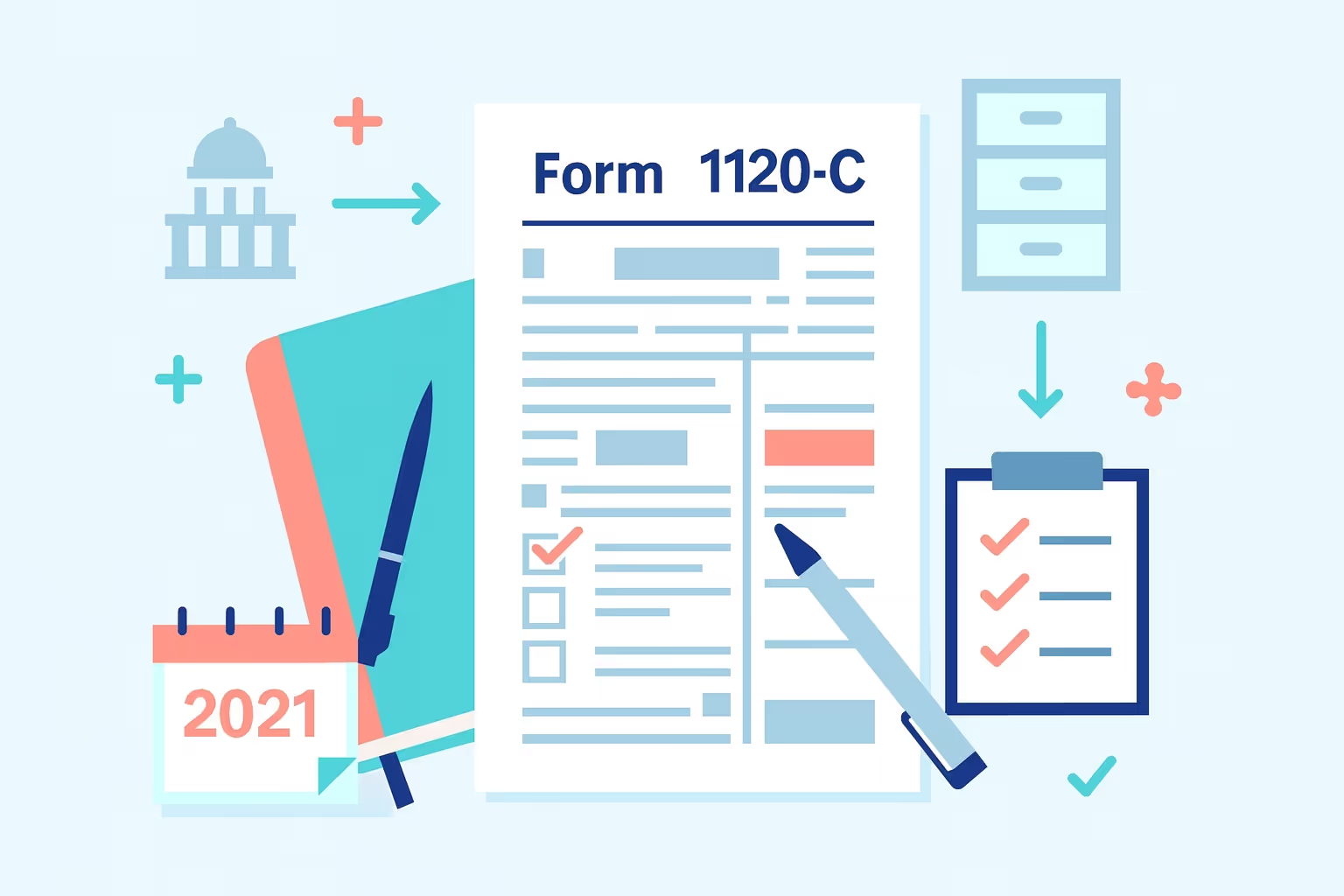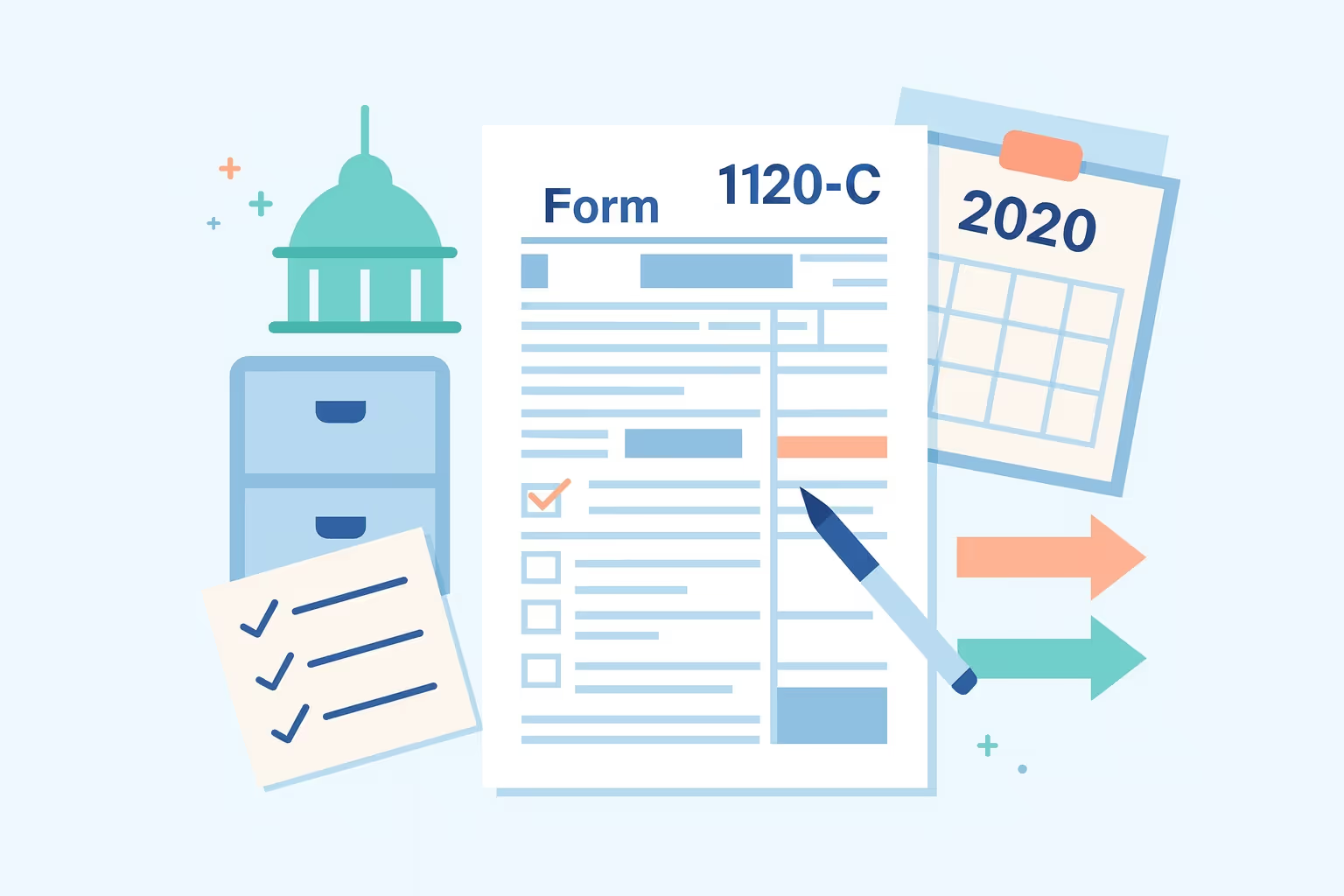Form 1120-C 2018 Instructions: Co-Op Filing Guide
Form 1120-C 2018 instructions provide essential guidance for cooperative associations required to file a federal income tax return for the 2018 tax year. This form, issued by the Internal Revenue Service, applies to corporations operating on a cooperative basis under section 1381 of the Internal Revenue Code. It is used to report income, deductions, credits, and other tax items that determine a cooperative’s overall tax liability. The 2018 version holds particular importance because it incorporates major updates from the Tax Cuts and Jobs Act, including the adoption of a flat 21 percent corporate tax rate that replaced the previous graduated system.
Cooperative associations—such as farmers’, marketing, purchasing, and supply co-ops—use Form 1120-C to classify patronage and nonpatronage income, calculate taxable income, and apply deductions related to business expenses, depreciation, and business interest expense. Completing this form correctly ensures compliance and helps avoid penalties or filing delays.
As tax laws evolve, the 2018 instructions remain a valuable reference for cooperatives that are amending prior-year returns or reviewing how changes in corporate taxation have affected their operations. This guide provides a step-by-step explanation of the filing process, including required schedules and forms, enabling cooperatives to accurately report their income and deductions while remaining compliant with IRS requirements.
Understanding Form 1120-C
Form 1120-C is the U.S. Income Tax Return for Cooperative Associations, used by cooperatives to report income, deductions, and credits to determine their federal income tax. It applies to corporations operating on a cooperative basis under section 1381 of the Internal Revenue Code. Completing this form ensures that the cooperative’s taxable income, profits, and payments to members are accurately recorded and taxed in accordance with federal rules.
What Is Form 1120-C Used For?
Form 1120-C allows cooperative associations to report several key financial components:
- It reports income earned from both member and nonmember business operations.
- It includes deductions such as business expenses, depreciation, and dividends paid to members.
- It accounts for credits that reduce the cooperative’s overall tax liability.
- It reports adjustments from the preceding tax year or losses carried forward under net operating loss provisions.
Who Must File Form 1120-C?
The Internal Revenue Service (IRS) requires the following entities to file Form 1120-C:
- Farmers’ cooperatives that are organized and operate under Section 521.
- Nonexempt cooperatives that operate on a cooperative basis but do not qualify under Section 521.
- Corporations that allocate profits to patrons based on the volume of business conducted with or for them.
- Other cooperative associations that earn income from members and conduct business primarily for their benefit.
Organizations that are exempt from filing include mutual savings banks, life insurance companies, real estate investment trusts, and regulated investment companies.
Cooperative Classifications
Cooperatives fall into two main categories:
- Farmers’ tax-exempt cooperatives: Qualify under section 521 and receive special deductions, such as dividends on capital stock and patronage dividends.
- Nonexempt cooperatives: Operate on a cooperative basis but are taxed as standard C corporations without Section 521 deductions.
Both types must calculate gross income, deductions, and adjusted taxable income before determining their final tax shown on Form 1120-C.
Correctly classifying the cooperative ensures compliance with federal tax law and helps determine eligibility for specific deductions and credits. Understanding these distinctions also helps cooperatives align their business structure with the correct reporting obligations before completing the next step—analyzing the 2018 tax law changes that directly affect how Form 1120-C is filed.
2018 Tax Law Changes Affecting Cooperatives
The 2018 tax year introduced major adjustments through the Tax Cuts and Jobs Act, reshaping corporate taxation for cooperative associations. These changes influenced how taxable income, deductions, and credits are calculated and reported on Form 1120-C. Understanding these revisions helps cooperatives ensure accurate reporting and avoid compliance issues when preparing their income tax return.
Overview of the Tax Cuts and Jobs Act
The Tax Cuts and Jobs Act (TCJA) replaced the graduated corporate tax structure with a flat rate of 21 percent. This single rate simplified tax computation for most corporations, including cooperative associations. Additionally, several deductions were repealed or revised, and new provisions were added to address international income, business interest expense, and base erosion taxes.
Key 2018 Tax Law Updates
- Flat Rate and AMT Elimination: The corporate alternative minimum tax (AMT) was repealed, allowing cooperatives to apply any prior AMT credits as refundable amounts.
- Domestic Production Activities Deduction (DPAD) Repeal: The Section 199 deduction was eliminated for most filers, except for certain pass-through entities with tax years before 2018.
- New International Provisions: Cooperatives with foreign corporations must now report Global Intangible Low-Taxed Income (GILTI) and may qualify for deductions related to Foreign-Derived Intangible Income (FDII).
- Business Interest Expense Limitation: New rules limit interest deductions to 30 percent of adjusted taxable income. Cooperatives exceeding this threshold must complete Form 8990.
- Net Operating Loss (NOL) Changes: NOLs can be carried forward indefinitely, but are limited to 80% of the taxpayer's taxable income for carry-forward purposes.
- New Tax Credit: Cooperatives can claim a credit for paid family and medical leave using Form 8994.
These changes had lasting effects on cooperatives and other corporations, generally shaping how they calculate income, manage deductions, and plan future tax years.
Step-by-Step Filing Instructions
Before You Begin:
- Verify the cooperative’s classification under section 1381 or 521 and confirm the accounting method that applies for the current tax year.
- Gather financial statements, income records, prior-year tax items, and documentation of estimated tax payments.
- Ensure that all accounts are reconciled and that necessary forms—such as those for depreciation or foreign income—are identified before filing.
Step 1 – Completing the Header.
- Enter the cooperative’s legal name, address, EIN, and correct tax year to ensure proper IRS processing.
- Check the boxes for the type of return being filed and indicate whether it is a farmer’s tax-exempt or nonexempt return.
- Confirm that an authorized officer will sign the return by the due date.
Step 2 – Reporting Income (Lines 1–10).
- Report gross receipts, returns, and allowances to calculate total income.
- Include dividends, interest, rents, capital gains, and other income from domestic and foreign sources.
- Separate patronage and nonpatronage income for Schedule G to maintain accurate reporting.
Step 3 – Claiming Deductions (Lines 11–24).
- Deduct business expenses such as salaries, rent, taxes, and depreciation, attaching Form 4562 if needed.
- Apply the business interest expense limitation using Form 8990 if applicable.
- Record patronage dividends and section 1382 deductions with supporting documentation.
Step 4 – Calculating Taxable Income (Lines 25–27).
- Subtract total deductions from total income to determine taxable income.
- Apply special deductions from Schedules C and H and allowable credits to calculate federal income tax.
- Use the 21 percent flat rate and reconcile results on Schedule J to confirm total tax liability.
Step 5 – Attaching Required Schedules.
- Include all relevant schedules—C, G, H, J, K, L, and M-1—based on cooperative activity.
- Attach supporting forms such as 1125-A, 4562, and 8990–8993 in the correct sequence.
- Review for completeness and ensure all documents include the cooperative’s name and EIN.
Filing and Submission Options
Cooperatives may file Form 1120-C electronically or by mail, depending on the availability of e-file services and their filing preferences. Each filing method must follow the IRS deadlines for the corresponding tax year.
Filing Deadlines
The due date depends on the cooperative’s fiscal year:
- Section 6072(d) cooperatives must file by the 15th day of the ninth month after the tax year.
- Other cooperatives must file by the 15th day of the fourth month following the end of the year.
- Fiscal year filers with a June 30 year-end must file by the 15th day of the third month after the close of the tax year.
Requesting an Extension
To request more time to file, cooperatives may submit Form 7004 by the original due date. The extension grants an additional six months to file the tax return, but does not extend the time for paying taxes owed. Payment of the estimated tax liability must accompany the extension request.
How to File?
- Electronic Filing: Recommended for faster processing, fewer errors, and confirmation of receipt.
- Paper Filing: If filing by mail, send the return to the appropriate IRS address listed in the official Form 1120-C instructions. Include payment, if required, and maintain a copy for business records.
Ensuring the correct submission method and meeting all filing deadlines prevents penalties and supports compliance with Internal Revenue Service requirements. The following section explains how to make payments and estimated tax deposits efficiently.
Payment and Estimated Tax Requirements
Cooperative associations must use approved electronic methods to make federal income tax payments and estimated tax deposits to the Internal Revenue Service. Doing so ensures compliance, timely posting of payments, and avoidance of penalties.
Mandatory Electronic Payments
- Cooperatives are required to use the Electronic Federal Tax Payment System (EFTPS) for all federal tax deposits, including those for balances due and estimated payments.
- Enrollment in EFTPS requires an Employer Identification Number and bank information, allowing cooperatives to schedule payments and receive confirmation of successful transactions.
Alternative Payment Methods
- Cooperatives that cannot use EFTPS may pay electronically through an authorized credit or debit card processor.
- Electronic funds withdrawal is available when filing electronically and links the payment directly to the submitted return.
- Bank wire transfers can be used for large or time-sensitive payments if processed through approved channels.
Estimated Tax Payments
- Cooperatives must make estimated tax payments if they expect to owe $500 or more in federal income tax for the current year.
- Quarterly payments are due on the 15th day of the 4th, 6th, 9th, and 12th months of the tax year, based on projected taxable income or the prior year’s results.
- Making estimated tax payments on time prevents underpayment penalties and keeps the cooperative’s tax account in good standing.
Required Schedules and Forms
Filing Form 1120-C requires attaching specific schedules and supporting forms that provide detailed explanations of income, deductions, and credits for the IRS.
Key Schedules to Include
- Schedule C reports dividend income and calculates allowable special deductions for cooperative associations.
- Schedule G separates patronage and nonpatronage income to determine how business profits are allocated.
- Schedule H lists deductions under section 1382, including patronage dividends paid to members.
- Schedule J calculates the total tax liability, incorporating applicable tax credits as needed.
- Schedules K, L, and M-1 provide other essential details such as accounting methods, balance sheets, and reconciliation of income differences.
Supporting Forms
- Form 1125-A reports the cost of goods sold for cooperatives with average annual gross receipts over $25 million.
- Form 4562 documents depreciation and amortization for business property or equipment.
- Forms 8990–8993 cover business interest expense limitations, base erosion tax, and foreign-source income deductions.
- Form 7004 allows cooperatives to request an automatic extension of time to file the tax return.
Attaching these schedules and forms in the correct order ensures accuracy and reduces processing delays. Filers should cross-check the official IRS instructions for 2018 before submission.
Common Mistakes and How to Avoid Them?
Accurate filing of Form 1120-C helps cooperatives avoid costly delays and IRS correspondence. Understanding common errors allows organizations to correct issues before submitting their return.
Frequent Filing Errors
- Many cooperatives misclassify their entity type by failing to verify whether they qualify as section 521 exempt or nonexempt.
- Some filers incorrectly combine patronage and nonpatronage income instead of reporting them separately.
- A common mistake is applying outdated tax rates instead of the 21 percent flat corporate rate required for 2018.
- Filers often overlook required schedules or attach them in the wrong order, which can delay return processing.
- Using checks instead of electronic payments may result in noncompliance penalties and slower processing times.
Preventive Steps
- Cooperatives should carefully review prior-year returns, verify current-year calculations, and maintain complete documentation for all income and deductions to ensure accuracy and compliance with relevant regulations.
- Consulting a tax professional ensures accurate reporting and helps address complex issues such as adjusted taxable income or international activities.
- Reviewing payment confirmations and filing deadlines before submission helps maintain compliance and prevent unnecessary inquiries from the IRS.
Attention to these areas improves accuracy and efficiency, ensuring a smooth filing experience for cooperative associations.
Filing for Dormant or Zero-Activity Cooperatives
Even if a cooperative has no income or business activity, it is generally required to file Form 1120-C unless it has been formally dissolved. Filing a zero-activity return maintains compliance with federal tax law and preserves the cooperative’s legal standing with the Internal Revenue Service.
When to File a Zero-Activity Return?
- A cooperative must file if it remains legally registered but did not receive income, conduct business, or distribute dividends during the tax year.
- Filing is also required when the cooperative temporarily suspends operations but plans to resume business in a future year.
How to Complete a Zero-Activity Return?
- Enter the cooperative’s legal name, address, Employer Identification Number, and tax year on Form 1120-C.
- Select the appropriate cooperative type from the options in Box C.
- Report zeros on income and deduction lines, and complete Schedule K and Schedule L if applicable.
- Sign and date the form before submission to confirm accuracy.
Maintaining Status During Dormancy
- Cooperatives should maintain an active corporate charter, file required state reports, and hold annual meetings, even during periods of inactivity.
- Maintaining accurate records allows the organization to resume operations or formally dissolve without complications.
Filing a compliant zero-activity return helps cooperatives avoid penalties and ensures that the organization remains in good standing with both the IRS and state authorities.
First-Time Filer Guidance
Filing Form 1120-C for the first time can seem complex, but understanding key steps simplifies the process and helps new cooperatives remain compliant. Proper preparation ensures accurate reporting of income, deductions, and tax liability.
Determining Eligibility
- A cooperative must confirm that it operates under Section 1381 and allocates profits to its members based on the business conducted with or on their behalf.
- The organization should identify whether it qualifies as a section 521 exempt or nonexempt cooperative to apply the correct tax rules.
Recordkeeping and Accounting Methods
- New cooperatives should establish accounting systems to separately track patronage and nonpatronage income.
- The cooperative must select an accounting method—either the cash or accrual method—based on its average annual gross receipts and operational complexity.
Planning Patronage Distributions
- Patronage dividends must be paid within eight and one-half months after the end of the tax year to qualify for a deduction.
- Cooperatives should calculate available profits, determine how much will be distributed in cash or written notices, and maintain documentation for all payments made to members.
When to Seek Professional Help?
- New filers should consult a qualified tax professional if they have complex income sources, multiple member types, or uncertainty about IRS reporting requirements.
- Professional advice can also help new cooperatives apply special rules and deductions correctly, thereby avoiding future filing errors.
Understanding these basics allows first-time filers to meet IRS requirements efficiently and establish accurate reporting practices for future tax years.
Frequently Asked Questions
What is the Form 1120-C 2018?
The Form 1120-C 2018 instructions guide cooperative associations in completing their federal income tax return for that tax year. Issued by the Internal Revenue Service, the form enables corporations to report their income, deductions, and credits. It ensures that taxable income, patronage dividends, and other tax items are accurately recorded, allowing cooperatives to comply with federal tax law and avoid penalties under the corporate taxation rules introduced by the Jobs Act.
How is taxable income determined for cooperative associations?
Taxable income is calculated by subtracting allowable deductions and business expenses from gross income. Cooperatives must apply the 21 percent flat rate introduced by the Jobs Act to their adjusted taxable income. Special rules allow deductions for patronage dividends and section 1382 items. Any net operating loss from a preceding tax year can be carried forward indefinitely to reduce future tax liability.
When are estimated tax payments due for cooperatives?
Cooperatives must make estimated tax payments if they expect to owe at least $500 in federal income tax for the current year. These payments are generally due on the 15th day of the 4th, 6th, 9th, and 12th months of the tax year. Making estimated tax payments on time prevents underpayment penalties and ensures that the tax shown on the income tax return matches the Internal Revenue Service's records.
What deductions and credits can cooperatives claim?
Cooperative associations may claim deductions for business expenses, depreciation, and interest, as well as certain payments made to members as patronage dividends. They can also qualify for specific tax credits under federal tax law. These deductions and credits reduce taxable income, helping cooperatives manage their tax liability, provided they follow the applicable reporting rules for corporations.
Can Form 1120-C be filed electronically?
Yes, Form 1120-C can be filed electronically using IRS-approved software. Electronic filing provides faster processing, reduces errors, and allows secure transmission of income tax data through the locked padlock icon system. Cooperatives that prefer paper filing must mail their income tax return to the appropriate IRS address by the due date listed in the official instructions for the current year.
When should a cooperative consult a tax professional?
A cooperative should consult a tax professional when handling complex tax items such as foreign corporations, base erosion provisions, or business interest expense limits. Professional guidance ensures the organization applies deductions correctly and understands changes to tax law. This support is also helpful for verifying tax liability, interpreting special rules, and managing compliance with corporate taxation requirements across multiple tax years.















